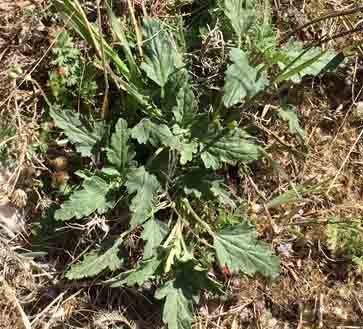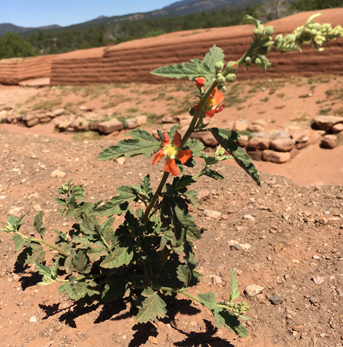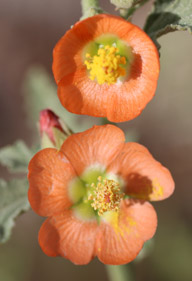
Location
On the trail at the church and on the church wall (N3D32'59.718 X W105D41'21.180)
Flowers first observed: 6/14/17
The Plant
 |
 |
The Flowers

Distribution
"Mallows are common along roadsides and in rangelands throughout the United States (7). Sphaeralcea is a common genus in the Southwest, and all 5 subspecies of Fendler's globemallow are found in Arizona. Some subspecies are also found in NM, Texas, Nevada and California (6). "(jan.ucc.nau.edu)
Description
"Grows to 3ft tall and can become shrub-like. Leaves are divided into two smaller side lobes and a larger central lobe, all with scalloped edges and appear more green than the other Globemallows. Flowers are over 1" across and less cup-like than the other Globemallows" (Rocky Mountains Flora)
Ethnobotanical Uses
Food:
"The fruits of all globe-mallows are edible. Their pollen and seeds have been found at Chaco Canyon, Pecos, and on the Rio Grande near Zia and Santa Ana in archaeological contexts, suggesting that they were regularly eaten. In fact, globe-mallow seems to be one of the most widely used plants during this Anasazi era." (Dunmire and Tierney 187)
"The roots were sometimes chewed to reduce hunger when food was scarce." (Kershaw 140)
Medicine
"--- the root was also pounded and mixed with a little saltwater as a poultice to draw infection from sores and boils. A similar use is known for other pueblos: at Santa Clara, globe-mallow may be rubbed on sore muscles (because of the fine, stiff, star-shaped hairs on the foliage, the plant probably irritates the skin and brings blood to the affected area).
Other medicinal properties have been attributed to globe-mallow, but medicine for sore eyes, as in one of its colloquial names, 'sore-eye poppy', is definitely not one of them. This name probably is as result of children having eaten the buds or fruits of the plant and then irritating their eyes by rubbing them with hands covered with the fine but scratchy star-shaped leaf hairs" (Dunmire and Tierney 188)
"At Tularosa, New Mexico, a midwife told me you must boil a small piece of the root in a glass of water to obtain a purge. This must be taken three times a day or before breakfast whenever necessary.
If a decoction of the plant is drunk every morning for nine days, it is supposed to act as a diuretic."(Curtin 189)
"For the Navajo, globemallow is a Life Medicine, useful for treating colds and headache, stimulating the appetite, and settling and upset stomach." Native Americans used the roots to help make casts for broken bones, to stanch bleeding , to soothe teething pain, and to poultice sores and snakebites."(Finley and Nieland 34)
"Several species of Sphaeralcea used by Navajo, Hopi, Tewa and Keres for treatment of colds, sores, snakebite, stomachache, and diarrhea; ..." (Littlefield and Burns 163)
"Used by Navajo as an infusion to stop bleeding, a tonic to cure coughs and colds ..." (Littlefield and Burns 164)
"Plant used for sand cricket bites. --- Infusion of plant taken for sore mouth. --- Cold, compound infusion of plant taken for internal injury and hemorrhage. --- Infusion of plant used as lotion for external injury." (Moerman 540)
Other Uses:
"Utilization of this plant definitely has carried over into historical times. The people of Santo Domingo have boiled globe-mallow and added it to gypsum as a glue for calcimine house paint. At Taos the pulp of the plant has been mixed with mud to make very hard floors." (Dunmire and Tierney 187-8)
"Tea made from scarlet globemallow was use as a remedy for diseases caused by witchcraft. ---The fuzzy leaves have been recommended as a soothing shoe-liner." (Kershaw 140)
"Globemallows contain mucilage that soothes or stiffens, depending on the application. The Navajo name 'gummy medicine' acknowledges this sticky property. After washing their hair some Native Americans would rinse it with an infusion of globemallow as a conditioner to add shine and softness. If they desired a stiffer 'hairdo,' they would allow the globemallow infusion to dry in the hair without rinsing it out." (Finley and Nieland 34)
"... as a source of pigment for face paint, as a glue-like substance to hold feathers and cotton on skin during dances or to mix with mud to make floors hard."(Littlefield and Burns 163)
Internet Links